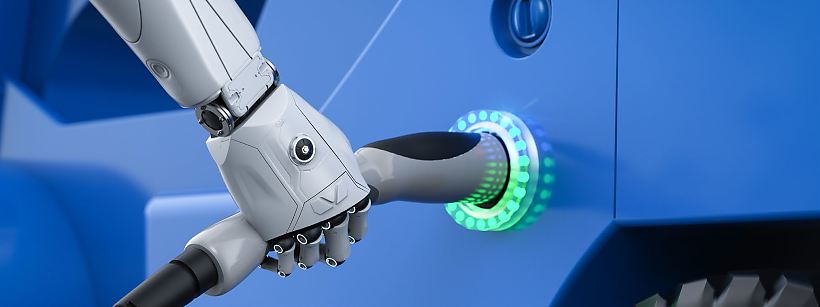In this article, we explore future innovations in electric vehicle charging infrastructure that will help advance adoption into van fleets. To combat rising electricity costs, we also investigate how you can maximise your current charging strategy.
Improvements in battery range, vehicle choice and charging infrastructure mean electric vans have become an increasingly practical option for fleet operators. However, rapid charging has steadily become more costly in recent months. The Advisory Electricity Rate (AER) reimbursement is only set to increase to 8 pence per mile. Businesses are feeling the pinch more than ever. In hard times it is essential to remember there is industry support to help you effectively manage your EV fleet. With support, you can implement an efficient electric vehicle charging strategy to combat rising electricity costs.
To begin with, let us focus on revolutionary new electric vehicle charging technologies that are on the horizon. Exciting developments from e-highways to lamp post chargers will increase adoption and support convenience for electric vehicles in day-to-day life.

1. Paving the way for e-highways
Heavy Goods Vehicles (HGVs) emit 18% of all road vehicle CO2 emissions, despite only representing five per cent of the total miles driven. Subsequently, plans for a network of ‘e-highways’ are already underway.
North East Lincolnshire conducted a nine-month feasibility study into HGVs recharging using overhead wires on UK motorways. This is part of a £20 million funding package for zero-emission road freight from the Department for Transport.
Despite dissenting voices, the Centre for Sustainable Road Freight has said that catenary, dynamic charging systems are “technically viable, economically attractive and could be achieved by late 2030”.
The Department of Transport is holding a competition to enable transport companies to test e-highways. The winning transport companies will be announced in mid-December 2022. They will be able to utilise e-highway infrastructure to decarbonise their business whilst trialling innovative new electric vehicle charging techniques. The competition will also provide national evidence to assess the viability and infrastructure requirements of hydrogen and battery electric HGVs.

2. Kerbside convenience: pop-up and lamp post chargers in the spotlight
Pop-up and lamp post chargers are offering a convenient, space-saving solution to on-street charging. Up to 60 per cent of van drivers will not have access to private parking or depot charging and, consequently, are unable to easily charge their vehicles when needed.
Shell subsidiary Ubitricity, for example, has been busy converting existing lamp posts into charging points for electric vehicles in UK residential areas and has already hit a 5,000-install milestone. The company is on a mission to install 50,000 across the country by 2025.
New Pop-up charging stations can retract into the ground so they’re flush with the pavement when not in use. These low-impact charge points, which can be activated using a smartphone app, are now being installed in cities such as Oxford, Dundee and Plymouth, funded by Innovate UK.

3. Electric charging robots
Could EV charging robots make charging more convenient? In the near future, charging stations may autonomously navigate through streets or car parks directly to you, saving you the time of looking for an available charging point.
Volkswagen has already shared its vision for a mobile charging robot, while Quanergy Systems, in partnership with iCent, recently showcased its next-generation charging robot, using LiDAR sensors, 3D perception software and AI at CES 2022.

How can you charge your electric vehicles more efficiently today?
When looking to optimise the charging of your electric vehicles, education is key. Here we explore three different ways you can increase the efficiency of your EV fleet.
Driver behaviour
Driver education for electric vehicles is key if you want to maximise your EV fleet operations. Teaching your driver energy-saving tips such as regenerative braking to regenerate energy back into the electric vehicle can positively affect their daily range. Creature comforts i.e. using air conditioning, can also drain the battery of the vehicle if used for extended periods of time. One way to combat this is to preheat/ pre-cool the cabin before you start your journey and are still connected to the main power. Small changes in the operation of the electric vehicle can have lasting effects on battery drainage and health.
When/how you are charging
Some electric van drivers will return to the depot at the end of the day and begin charging their electric vehicles at peak time. Instead of instantly charging your vehicles during the day, where possible, it is better to use an off-peak tariff and charge overnight. Not factoring in peak/ off-peak charging times will impact your business energy consumption and is not cost-effective. Through smart charging your electric vehicles overnight, you will have effectively charged your vehicle whilst reducing your overheads.
Understanding charging curves
Whilst not currently common knowledge, it is important to understand that when charging your electric vehicle over 80% using a rapid charger the rate of charge decreases drastically. It is important to know the charging curve of your vehicle to ensure you are charging it to the optimum level, reducing the valuable time spent trying to charge it to 95%.
GET A STEP-BY-STEP GUIDE TO VAN ELECTRIFICATION
Download our short guide on the world of commercial van electrification.
Your journey
The transition to an electric fleet can be daunting. However, it is not too late to begin your electrification journey. Reading this article is a good start to considering your electrification strategy. The rapid development in charging infrastructure means there is more help than ever to support the transition to electric vehicles. Not sure where to start? Request a free consultation with one of our experts.










